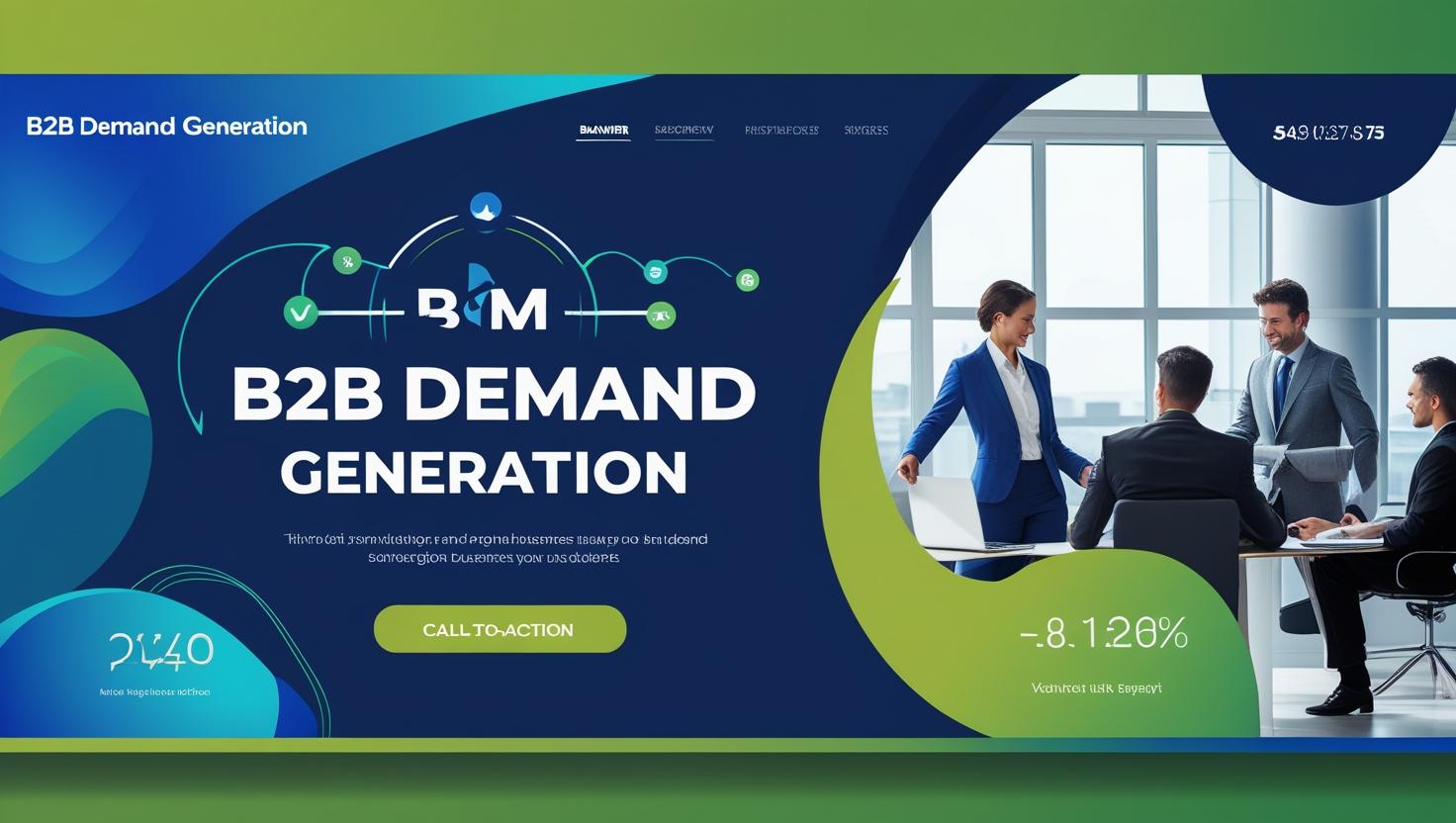Have you ever wondered how big companies The Power find new customers? It is a bit like a treasure hunt. Businesses want to sell their products or services to other businesses. This is called “B2B” – business-to-business. Finding these customers is super important for growth. Moreover, it helps companies make more money. We call this special process “demand generation.” It is about making other businesses interested. Furthermore, it encourages them to want what you offer. It is a big and exciting challenge.
Demand generation is more than just advertising. Indeed, it is a whole plan. It helps companies get noticed. Then, it makes them seem valuable. Think of it as planting seeds. You want those seeds to grow into big, strong trees. These trees represent new business deals. Therefore, every step is important. You want to attract the right kind of attention. This ensures your efforts are not wasted.
This process involves many steps. First, you need to know who you want to reach. What kind of businesses are they? What problems do they have? Next, you create messages that speak to them. These messages show how your product can help. Later, you share these messages in many places. This might be online or through events. Finally, you help interested businesses learn more. This guide will explore this fascinating world. We will discover how companies attract their ideal buyers. Also, we will see how they turn interest into sales.
What is B2B Demand Generation?
B2B demand generation is quite simple to understand. It is about creating interest. It makes other businesses want your solutions. Imagine a company selling special software. This software helps other companies manage their money. How do they find businesses that need this? They use demand generation. First, they teach potential buyers about money problems. Then, they show how their software solves these problems. This creates a need. Therefore, demand starts to grow.
This process is not just about making a sale right away. Instead, it is about building trust. It is about showing expertise. Companies want to be seen as helpers. They want to be seen as problem-solvers. Consequently, they share helpful information. They offer free guides. They host webinars. All these actions build good relationships. Furthermore, they make future sales easier. It is a long-term game. It focuses on value first.
Image 1 Description: An illustration showing a series of gears interlocking, each labeled with a step: “Awareness,” “Interest,” “Consideration,” “Decision.” Arrows show the flow between them, leading to a larger, central gear labeled “Growth.” The background is a clean, abstract design with soft, connecting lines, representing a continuous process.
This system is very organized. It has clear goals. Companies set targets for new interest. This helps them improve. Moreover, it makes their future campaigns stronger. It is a cycle of learning and improving. Demand generation is a core business activity.
The Foundation of Great Campaigns
Building a strong demand generation plan starts with knowing your audience. Who are you trying to help? What are their jobs like? What challenges do they face every day? Understanding these things is super important. It is like knowing your friend’s favorite food. You can then make them happy. Similarly, you can tailor your message. This makes it more likely to get noticed. Also, it helps it resonate more deeply.
Next, you need to figure out what makes your offering special. Why should another business choose you? What unique benefits do you provide? This is called your “value proposition.” It is your clear promise. It tells potential buyers why you are the best choice. Furthermore, it helps you stand out from competitors. Make sure your message is clear. Ensure it is easy to understand.
After that, you need to create compelling phone list content. This content attracts and educates. It could be blog posts. It might be videos. Maybe even detailed reports. The content should be helpful. It should answer common questions. Moreover, it should show your expertise. This builds credibility. It also positions your company as a leader. People trust experts more readily. Therefore, good content is key.
Identifying Your Ideal Customer
To create demand, you first need to know who you want to create it for. This is called identifying your “ideal customer profile” (ICP). Think of it as drawing a picture of your perfect client. What size is their company? What industry are they in? Where are they located? Are they growing fast? These details help you focus your efforts. This ensures you target the right businesses. Therefore, your marketing becomes much more effective.
Once you have your ICP, you can dig deeper. Who within that company makes decisions? What are their specific roles? What problems do they personally face? These are your “buyer personas.” It is like creating a character profile for each key person. Understanding their daily struggles helps you craft messages. These messages truly speak to them. This makes your outreach more personal. Also, it makes it more powerful.
For example, if you sell accounting software, your ICP might be small businesses. Your buyer persona might be the finance manager. The finance manager worries about mistakes. They also worry about saving time. Your messages would then focus on accuracy. They would also highlight time savings. This precision helps attract the right leads. It saves resources too.

Crafting Engaging Content
Content is the heart of demand generation. It is how you talk to your audience. However, it is not just about talking about yourself. It is about providing value. It is about helping others. Think about a helpful teacher. They explain difficult things simply. They give useful advice. Your content should do the same. It should educate and inform.
There are many kinds of content. Blog posts are common. They share insights and tips. E-books offer deeper knowledge. Webinars are live online talks. They allow hubspot transactional email: sending important messages interaction. Videos can explain complex ideas visually. Infographics present data easily. Each type serves a purpose. Each helps engage your audience differently. You should use a mix. This reaches more people.
Always remember the 7th-grade rule. Keep your language simple. Use short sentences. Avoid confusing jargon. Explain new terms clearly. Break up long paragraphs. Use headings often. This makes your content easy to read. It makes it easy to understand. Thus, more people will engage with it. And they will learn from it.
Spreading the Word: Distribution Channels
You have great content. Now what? You need to share it. This is called content distribution. Think of it like shouting from a mountaintop. You want your message to reach many ears. Where do your ideal customers spend time? Are they on social media? Do they read industry blogs? Do they attend online events? You must go where they are.
One popular way is through social media. LinkedIn is great for B2B. Companies and professionals use it. You can share your articles there. You can join sale leads group discussions. This helps you connect with others. It also helps you build your brand. Other platforms like X (Twitter) or Facebook can work too. It depends on your audience.
Email marketing is another powerful tool. You can send newsletters. You can share new content directly. This keeps your audience informed. It builds a direct line of communication. Make sure your emails are helpful. Do not just sell. Provide value first. This keeps people opening your emails. It keeps them engaged.
Paid advertising can boost your reach. You can run ads on Google. You can advertise on social media platforms. These ads target specific audiences. You pay to show your message. This can quickly get your content in front of many eyes. However, it costs money. So, plan your budget carefully.
Measuring Success: How Do We Know It’s Working?
After putting in all that effort, how do you know if it’s paying off? This is where measurement comes in. It is like checking your grades in school. You want to see how well you are doing. For demand generation, you track different things. These are called “metrics.” They tell you what’s working. They also show what needs improvement.
One important metric is website traffic. How many people visit your site? Where do they come from? Are they new visitors? More visitors often mean more interest. Another is engagement. How long do people stay on your pages? Do they click on links? Do they download your content? High engagement shows people like what you offer.
Then there are “leads.” A lead is someone interested. This shows they want to know more. Tracking leads is crucial. It shows you are attracting potential customers. Not all leads become customers. But they are the first step.
Image 2 Description: An illustration showing a stylized dashboard or computer screen with various simple graphs and charts. One graph shows an upward trend (labeled “Website Traffic”), another a pie chart showing different content types (e.g., “Blog,” “Video,” “E-book”). A small magnifying glass icon hovers over a number, indicating “Leads Generated.” The overall design is clean and digital, conveying data analysis.
Finally, you look at conversions. How many leads turn into sales? This is the ultimate goal. It shows the true success of your efforts. By tracking all these things, you can adjust your strategy. You can stop doing things that don’t work.
Learning and Adapting: The Ongoing Journey
Demand generation is not a one-time project. It is an ongoing journey. The business world changes fast. New technologies appear. Customer needs evolve. Therefore, your strategy must also evolve. You need to keep learning. You need to keep adapting. This helps you stay ahead. It ensures your efforts remain effective.
Regularly review your data. See what content performs best. Find out which channels bring the most leads. Ask your sales team for feedback. What kind of leads are they getting? Are they ready to buy? This feedback is priceless. It helps you refine your approach. It makes your demand generation smarter.
Think of it like a scientist. Then you adjust your hypothesis. You try again. This continuous improvement loop is vital. It ensures your demand generation keeps delivering results. It helps you grow your business sustainably.
Common Mistakes to Avoid
Even smart companies make mistakes. One common error is not knowing your audience well enough. If you don’t know who you’re talking to, your message will miss the mark. It’s like trying to sell ice cream to someone who wants a warm coat. Always start with deep audience research. This prevents wasted effort.
Another mistake is focusing only on sales. Demand generation is about building interest before the sale. If you jump straight to “buy now,” you might scare people away. First, provide value. Build trust. Educate your audience. Sales will follow naturally when the time is right. This approach builds stronger relationships.
Not measuring your results is also a big no-no. If you don’t track your metrics, you won’t know what’s working. You’ll be flying blind. Make sure you have tools to track website visits. Monitor lead generation. Look at conversion rates. Data guides your decisions. It helps you improve constantly.
Lastly, don’t be afraid to try new things. The digital world changes fast. New platforms appear. New content formats become popular. Experiment. Learn. Iterate. What worked last year might not work today. Stay curious. Stay flexible. This keeps your demand generation fresh. It keeps it effective too.
